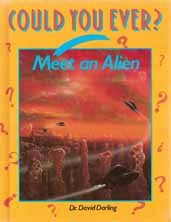COULD YOU EVER MEET AN ALIEN? Glossary
alien
In this book an alien is any form of life that did not develop on the Earth. It could be anything from a very simple creature, too small to be seen without a microscope, to a being more advanced and intelligent than ourselves.
amino acid
A substance that is a key building block for the most important substances – proteins and nucleic acids – in all living things on Earth. A number of different amino acids occur in nature.
ammonia
A colorless gas made of atoms of nitrogen and hydrogen. Ammonia gives the strong smell to many household cleaning fluids.
atom
A tiny particle of matter. Certain substances, such as hydrogen and carbon, consist of only one type of atom. Other substances, such as water, salt, or protein, are made up of more than one kind of atom.
billion
One thousand million, or 1,000,000,000.
carbon
A substance that, because it links together in huge chains and rings, can form the complicated chemicals needed for life.
carbon dioxide
A gas in the Earth's atmosphere. It is taken in by plants and breathed out by animals.
cell
The smallest living part of an animal or plant. Human beings have billions of cells, each performing a certain task.
DNA
Stands for deoxyribonucleic acid. DNA is the most important chemical in the cells of living things on Earth. It contains a complicated code by which the characteristics of one generation of living things are passed on to the next.
extraterrestrial intelligence
Intelligence that did not arise on Earth.
galaxy
A star city; the largest grouping of stars in the Universe. Our galaxy contains several hundred billion stars. Astronomers think there may be around 100 billion galaxies in all of space.
gravity
A force exerted by any object that has mass. The Earth's gravity prevents the atmosphere, and people, from floating away into space.
hydrogen
The lightest and most common substance in the Universe; normally found as a gas.
infrared light
We feel infrared light as "heat waves." For example, the warmth from a coal fire or from the Sun comes from infrared light. In most cases, infrared is given off by objects in space, such as planets, that are too cool to shine in ordinary light.
methane
A colorless, odorless gas made up of atoms of carbon and hydrogen.
nitrogen
A colorless, odorless gas that makes up nearly four-fifths of the air we breathe.
nucleic acids
Complex substances found in the bodies of all living things on Earth. They store the information needed for living things to grow and to make copies of themselves.
oxygen
A gas, making up about one-fifth of the Earth's atmosphere, that humans and all other animals breathe.
ozone
A gas, made from oxygen by the Sun's ultraviolet rays, that forms a protective layer high in the atmosphere.
planet
A round object, usually at least several thousand miles across, that is in orbit around a star. Planets give off no light of their own and are much cooler than stars. The Sun has none known planets, including the Earth. Many other stars also have systems of planets.
proteins
Substances built up from chains of amino acids. Proteins are found in all living things on Earth.
radio telescope
An instrument used by astronomers for picking up radio waves from space. It is much larger than an ordinary telescope and often consists of a metal "dish" many yards across.
red dwarf
A small, cool, faint type of star. Red dwarfs are the most common kind of
star in space, but even the nearest of them cannot be seen without the aid
of a large telescope.
Solar System
The part of space in which we live. It includes the Sun, the planets, and all the other objects that travel around the Sun.
star
A round, gassy object in space that makes its own light and heat.
sugar
A substance made from a long chain of carbon, hydrogen, and oxygen atoms. There are many different kinds of sugars. They are used by living things as a chemical store of energy.
Sun
The closest star to our planet and the one around which the Earth, and every other planet of the Solar System, revolves. The Sun seems much bigger and brighter than other stars because it is so much nearer to us.
trillion
One million million, or 1,000,000,000,000.
UFO
Stands for unidentified flying object. In other words, a UFO is any object seen in the sky for which there is no immediate or obvious explanation. Many UFOs turn out to be sightings of unusual clouds, the planet Venus, meteors, and aircraft. Very few remain unexplained for long; those that do are unlikely to be "flying saucer," or spacecraft from another planet.
ultraviolet rays
Similar to ordinary light, but invisible and more penetrating. Exposure to ultraviolet rays in the form of sunlight is the cause of sunburn.
water vapor
The gas that forms from water. It occurs in small amounts in the Earth's atmosphere.
wavelength
The distance between two neighboring crests of a wave. Light, radio waves, and other types of energy that reach us from space can be measured in terms of their wavelength.

